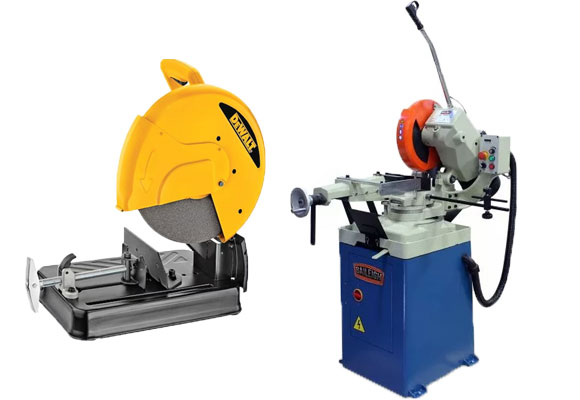
Cold Saw vs. Chop Saw: Features & Differences Explained
In the metalworking industry, using the right tools can significantly impact your project results in terms of precision, efficiency, and overall success. When it comes to the intricate task of cutting metal, professionals and enthusiasts often find themselves faced with a choice between two commonly used tools: the cold saw and the chop saw. While both tools serve the purpose of metal cutting, they possess distinct characteristics, working methods, and applications that set them apart. Today, we will provide a comprehensive exploration of cold saws and chop saws, focusing on their unique features and differences.
What is a cold saw?

(Image Source: baileigh.com)
A cold saw is a type of sawing machine designed primarily for cutting various metals. It can also be used for cutting other materials such as plastics and wood. Cold saws are commonly found in metalworking shops, fabrication facilities, and manufacturing industries. Unlike other saws that generate heat during the cutting process, a cold saw operates at lower speeds and uses a coolant or lubricant to keep the blade and workpiece cool. This cooling mechanism prevents the workpiece from becoming excessively hot and helps to preserve the structural integrity of the material being cut.
A cold saw mainly consists of a motor-driven spindle and a circular saw blade with teeth designed for cutting metal. A cold saw blade is made of high-speed steel (HSS) or carbide-tipped. With a quality cold saw blade, the cold saw machine can produce clean, precise, and burr-free cuts. The common diameter of a cold saw blade includes 6-1/2”, 5-3/8”, 10, 7-1/4”, 12”, 5-1/2”, and 14”.
For different cutting requirements, cold saws are often equipped with adjustable cutting angles and speeds.
What is a chop saw?

(Image Source: dewalt.com)
We are talking about the abrasive chop saw instead of the traditional chop saw. An abrasive chop saw is designed for cutting various hard materials, including metal, ceramics, tiles, and masonry. Unlike a traditional chop saw that utilizes blades with teeth, an abrasive chop saw employs an abrasive disc or wheel to finish the cuts. Chops saw discs are made of aluminum oxide or silicon carbide particles bonded together, allowing them to grind the workpiece. The most commonly used size of the abrasive chop saw disc is 14” in diameter.
Differences between a cold saw and an abrasive chop saw
Both cold saws and abrasive chop saws are designed for cutting metal, but there are several differences between them.
- Cutting Method
A cold saw employs a carbide-tipped circular saw blade or a toothed high-speed steel blade to cut the workpiece. During operation, the heat is transferred to the chips, ensuring the blade and the material stay cool. However, an abrasive chop saw operates by bringing the rotating abrasive disc down onto the workpiece and applying pressure to create the cutting action. The high-speed rotation of the disc generates friction and abrasion, effectively grinding through the material.
- Saw Blades
Cold saws and chop saws use different saw blades. Two types of circular saw blades are suitable for a cold saw machine: high-speed steel blades and carbide-tipped blades. Solid HSS cold saw blades are less durable than carbide cold saw blades. When dull or damaged, the HSS blade should be replaced. But a carbide cold saw blade can be resharpened, extending its service life.
Konetool, as a reliable B2B trading company, supplies top-quality carbide cold saw blades for aluminum. If you are looking for a new supplier, please do not hesitate to contact us today!

An abrasive chop saw works with an abrasive disc or wheel that has no teeth.

(Image Source: dewalt.com)
- Speed
An abrasive chop saw can run very fast compared to a cold saw. It is ideal for projects that require rapid cutting of tough metals, thanks to its high blade speed. Though a cold saw runs at a very low speed, usually between 22 to 88 RPMs, it can cut the workpiece faster.
- Precision
A cold saw can create much cleaner and more precise cutting finishes than an abrasive chop saw.
- Safety
When using a cold saw, your hands and neck are less likely to be burned by hot metal chips, making it a safety tool for metal cutting. The heat created during cutting is transferred to the chips, and by utilizing liquid coolant, the blade and workpiece stay cool. In addition, little dust or sparks are produced during the cutting process. In contrast, abrasive cutting causes both the disc and the workpiece to expand, generating heat through fraction.
- Price
The initial price of a cold saw is much higher than an abrasive chop saw. A manual cold saw may range from $1,300 to $6,000. The price of an automatic cold saw machine may range from $12,000 to $60,000. However, the cost of an abrasive chop saw ranges from $200 to $700.
- Cutting Material
Cold saws, with their slower blade rotation, have the ability to cut through a variety of metals including both softer materials like aluminum and tougher metals like rebar.
The abrasive chop saw is not suitable for cutting softer materials like aluminum, as it can cause the blade to clog and become ineffective. This type of saw is intended specifically for cutting hard metals. Nonetheless, it remains a favored machine in metal fabrication shops due to its cost-effectiveness and capability to efficiently cut through strong metals.